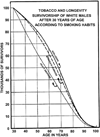Lung cancer: epidemiology, etiology, and prevention
- PMID: 22054876
- PMCID: PMC3864624
- DOI: 10.1016/j.ccm.2011.09.001
Lung cancer: epidemiology, etiology, and prevention
Abstract
Lung cancer is the leading cause of cancer death in the United States and around the world. A vast majority of lung cancer deaths are attributable to cigarette smoking, and curbing the rates of cigarette smoking is imperative. Understanding the epidemiology and causal factors of lung cancer can provide additional foundation for disease prevention. This article focuses on modifiable risk factors, including tobacco smoking, occupational carcinogens, diet, and ionizing radiation. It also discusses briefly the molecular and genetic aspects of lung carcinogenesis.
Copyright © 2011 Elsevier Inc. All rights reserved.
Figures

















References
-
- Siegel R, Ward E, Brawley O, et al. Cancer statistics, 2011: the impact of eliminating socioeconomic and racial disparities on premature cancer deaths. CA Cancer J Clin. 2011;61(4):212–236. - PubMed
-
- Jemal A, Bray F, Center MM, et al. Global cancer statistics. CA Cancer J Clin. 2011;61(2):69–90. - PubMed
-
- Howlader N, Noone AM, Krapcho M, et al., editors. SEER Cancer Statistics Review, 1975–2008. Bethesda (MD): National Cancer Institute; 2010. Available at: http://seer.cancer.gov/csr/1975_2008/, based on November 2010 SEER data submission, posted to the SEER web site, 2011.
Publication types
MeSH terms
Grants and funding
LinkOut - more resources
Full Text Sources
Other Literature Sources
Medical

